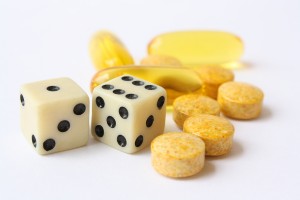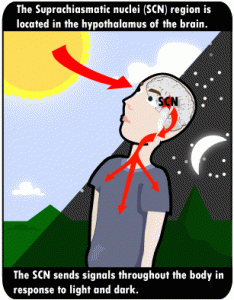This article is about the overuse of supplements that can create health risks. The Dietary Supplement Health And Education Act of 1994 made it easier for people to acquire supplements and vitamins from health food stores. But since then there has been a proliferation of various products that merchants sell as supplements and not as drugs. It may give you the impression that all supplements are harmless, but this is not so. There are some supplements like vitamin A where you need to watch that you are not inadvertently overdosing, as toxicity is a problem; calcium supplements are also potentially toxic, if overdone. And amino acid supplements (protein supplements) can lead to an overdose of brain hormones. Here is a sample of some of the supplements that I would want you to watch.
1.Vitamin A toxicity
Vitamin A is essential for normal night vision, for red blood cell production in the bone marrow and for the immune system. Here is a brief review about its metabolism. But while small amounts are beneficial for the body, high doses are toxic. In the 19th century the Arctic explorer Elisha Kane reported that consumption of polar bear liver caused severe headaches, drowsiness, irritability and vomiting within a few hours of ingesting it.
The underlying condition is due to “pseudotumor cerebri”. This is a condition that mimics a brain tumor, but coms from an acute overdose of vitamin A contained in liver (Ref. 1).
In the US where people eat enough meat, fish and dairy products, there is no overt vitamin A deficiency. Read this link to avoid overdosing with vitamin A in multiple supplements.
2. Vitamin C
Vitamin C is an important antioxidant vitamin. It plays a role as a cofactor for many metabolic reactions. It is participating in the production of collagen and connective tissues, helps with fatty acid transport and is necessary for the synthesis of neurotransmitters in the brain (Ref.2). The lack of vitamin C has the name scurvy; symptoms include bleeding gums from fragile capillaries, delay in wound healing and impaired bone metabolism. In the earlier research the hope was that vitamin C would prevent colds and cure cancer. More recent re-evaluations found that vitamin C does not prevent you from getting colds. Instead it accelerates the recovery from colds by cutting down the recovery time by as much as 25 to 30%. It also has some cancer protective effects (Ref.2).
1500 mg of vitamin C per day the upper limit
Higher doses seem to be more beneficial, but 1500 mg per day seems to now be the consensus of a reasonable upper dose limit per day. What about kidney stones? Several studies in the past have warned that vitamin C may in some people experience a breakdown into calcium oxalate kidney stones. Here is a brief review of the literature with regard to kidney stone formation. A study regarding the DASH diet, which is used for people with high blood pressure, showed that the incidence of kidney stones is almost half for both men and women compared to controls on a normal North American diet.
Kidney stones from vitamin C a myth
There has been a concern among the medical community that vitamin C as a supplement would increase kidney stones (oxalate stones). However, a 2014 study showed that when both vitamin C and vitamin E are taken as supplements, the kidney stone formation goes down.
Many inhabitants of industrialized countries including the population in the US and other countries are magnesium deficient and this can be a major factor for forming calcium oxalate stones. But it has been known for decades that those who develop kidney stones excrete more oxalates in their urine (so-called “oxalate excreters”). Here is a 1996 study that measured this in detail.
Green smoothies contain a lot of vitamin C
If you are taking in a lot of green smoothies from green leafy vegetables (spinach, kale, Swiss chard) that are high in water-soluble vitamins, you may not require any vitamin C supplements. In other words, think about what else you do and eat and add it up, so you do not exceed a total of 1500 mg to 2000 mg of vitamin C per day.
3. Calcium supplements
Calcium is a key mineral in the body, important not only for healthy bone structure, but also to balance the electrolytes within the blood, in the extra cellular fluid space and within our cells. If calcium is low, the brain is more prone to seizures and the heart can produce dangerously irregular heart beats. We definitely need a balance of calcium! Because calcium is so central to our wellbeing, several factors work together to keep our calcium levels stable: the kidneys, the thyroid, the parathyroid glands, the adrenal glands, the bone as a reservoir of calcium, the gastrointestinal tract for absorption and a good, balanced nutrition. The chapter on “Vitamins and Minerals” of Ref.3 points out that 4000 mg of calcium per day definitely causes toxicity (hypercalcemia and milk-alkali syndrome).
Absorption of calcium
Absorption of calcium depends on the dose you take meaning that only 500mg of calcium carbonate crosses the gut/blood barrier at a time. Vitamin D3 deficiency leads to reduced calcium absorption. But with high doses of vitamin D3, which is now often recommended, more calcium is absorbed, so it is important not to take too many calcium supplements. They can also interfere with iron and zinc absorption and when more than 2600 mg of calcium is taken magnesium absorption is inhibited as well. Calcium can interfere with thyroid hormone supplements (take 4 hours apart) and may reduce the effect of calcium channel blockers, drugs used for angina or high blood pressure.
99% of body calcium stored in bone
There is a balance between calcium stored in bone (99% of total body calcium) and the circulating portion of 1% of calcium in the blood. The parathyroid hormone and calcitonin are also involved in this balance. Hypercalcemia is the condition when calcium is too high. Common causes are the improper use of diuretics (thiazide diuretics), overuse of calcium carbonate supplementation (often for osteoporosis) and overuse of vitamin D3, which increases the absorption of calcium (Ref.3). See your family doctor for blood tests and advice what to do in your case.
4. High protein diets and protein (amino acid) supplements
Many protein supplements are available through health food stores and vitamin stores. The advertisers often state that our food would be substandard and these supplements would help “to regain strength”. Athletes hope to get stronger muscles from amino acid supplements because they are the building block for protein that builds up muscles. Fact is that no supplements are needed when you eat balanced meals containing meat and fish and you exercise regularly. The protein in your food will be broken down into amino acids and your body metabolizes this into your own protein. Here is a website that reviews the subject of supplementation with amino acids.
Protein supplements or not?
It is clear from this that this is a rather complex problem. Vegetarians may require these supplements to replace protein for the missing meat intake. But the rest of us have to guard ourselves against overdosing with too much meat, amino acids supplements or protein supplements.
High protein diets (Atkins diet and others) have been glorified as being helpful for weight loss. But the long-term effect of such diets lead to chronic kidney damage in those with diabetes and high blood pressure as evidenced by protein leakage in the urine (called ”microalbuminuria”, Ref.4).
Reference range for protein requirement
According to this reference the average protein requirement is 0.6 g of protein/kg body weight/day. This text comments that this would be compatible with the World Health Organization (WHO) recommendation for protein intake. For a person weighing 140 lbs. this translates into about 50 grams of protein per day. Here is a website that explains the upper limit of meat intake with the example of an 8-ounce portion of top sirloin steak.
Protein supplements have become very popular, but you need to be careful when you supplement with this that you do not get an overdose of amino acids. Amino acid profiling has been useful for physicians and naturopaths to examine deficiencies in children or adults checking for essential amino acids in the blood.
Overuse of meat from food and protein supplements
In industrialized countries like the US, Canada and others the larger concern is now the overuse of meat. Atkins-like diets and protein supplements are also a source of extra amino acids. The same amino acid screening tests will find several of the ingredients (amino acids) in these protein supplements to be too high. In this case it is imperative to stop the protein supplements to prevent amino acid toxicity.
This study warns that not enough is known how performance-enhancing supplements affect the metabolism of the body. There are discussions that perhaps upper limits for amino acid supplements need to be established.
5. Creatine supplementation
Creatine supplementation in the sports-minded and in athletes who want to build up muscle mass is of concern. The liver synthesizes creatine from amino acids, which derive from fish and meat. The body breaks this down into the amino acids arginine, glycine and methionine. There is no shortage of these amino acids, but athletes and sports minded people want to push the envelope. They consume additional creatine for their energy metabolism (ATP production) in the muscles to increase their performance (Ref. 5). Creatine is vital for the brain, the heart, the kidneys and the eyes (retina). It is a buffer for lactic acid during anaerobic exercise. Some of the side effects are muscle cramps, diarrhea, fluid retention and kidney failure. Exposure to high heat and dehydration aggravates this. There are no long-term studies of the use of creatine supplements, yet many athletes take them all the time.
Conclusion
We are tempted by various merchants and infomercials to take in more and more vitamins and supplements. This includes protein and amino acid supplements. But when you eat well-balanced meals, preferably organic food, you already have enough nutrients. This includes protein, nutrients, calcium, vitamin C and vitamin A in your food. So you may be inadvertently putting a strain on your kidneys. They have to eliminate whatever it is that is too much for your body to take. Your liver may also be quietly working overtime as well.
Limits of your organs
Your brain gets overactive by the surplus of amino acids that are utilized by the brain to make brain hormones. Your system can only take so much; at one point a surplus of supplements will make you sick! So, be vigilant and think about what your regular food intake already provides. Do you really need that supplement or do you already get enough from your food intake? Are you falling for some marketing scheme? Remember, you are the steward of your own health!
References
1.Shannon: Chapter 69: The Vitamins. Haddad and Winchester’s Clinical Management of Poisoning and Drug Overdose, 4th ed.© 2007 Saunders
2. Mandell: “Water-Soluble Vitamins”. Mandell, Douglas, and Bennett’s Principles and Practice of Infectious Diseases, 7th ed. © 2009 Churchill Livingstone
3. Rakel: Chapter “Disturbances in Calcium and Phosphate” and chapter entitled “Vitamins and Minerals”. Textbook of Family Medicine, 8th ed. © 2011 Saunders
4. “High Dietary Protein Intake” in “Taal: Brenner and Rector’s The Kidney”, 9th ed. © 2011 Saunders
5. DeLee: DeLee and Drez’s Orthopaedic Sports Medicine, 3rd ed. © 2009 Saunders







